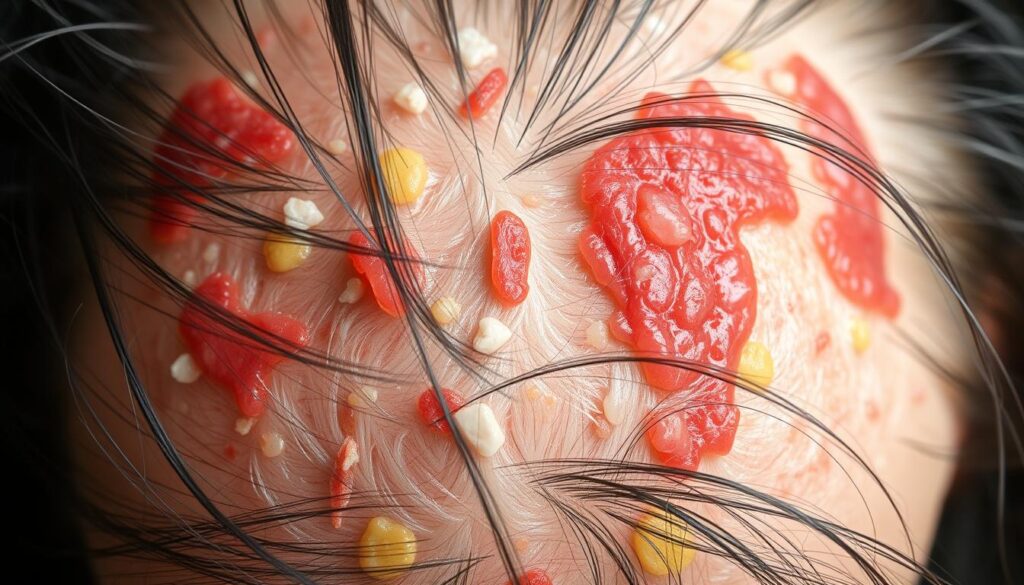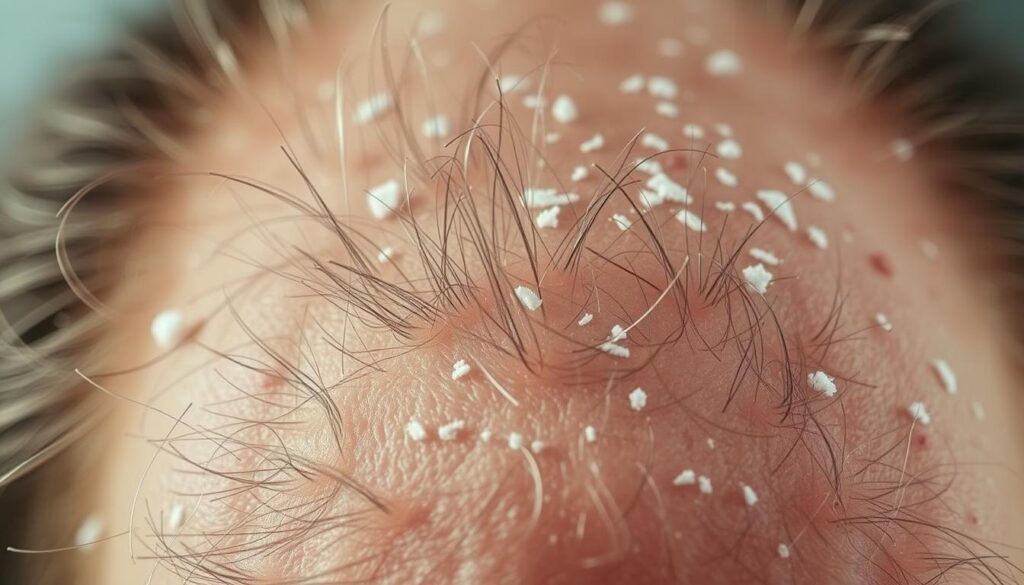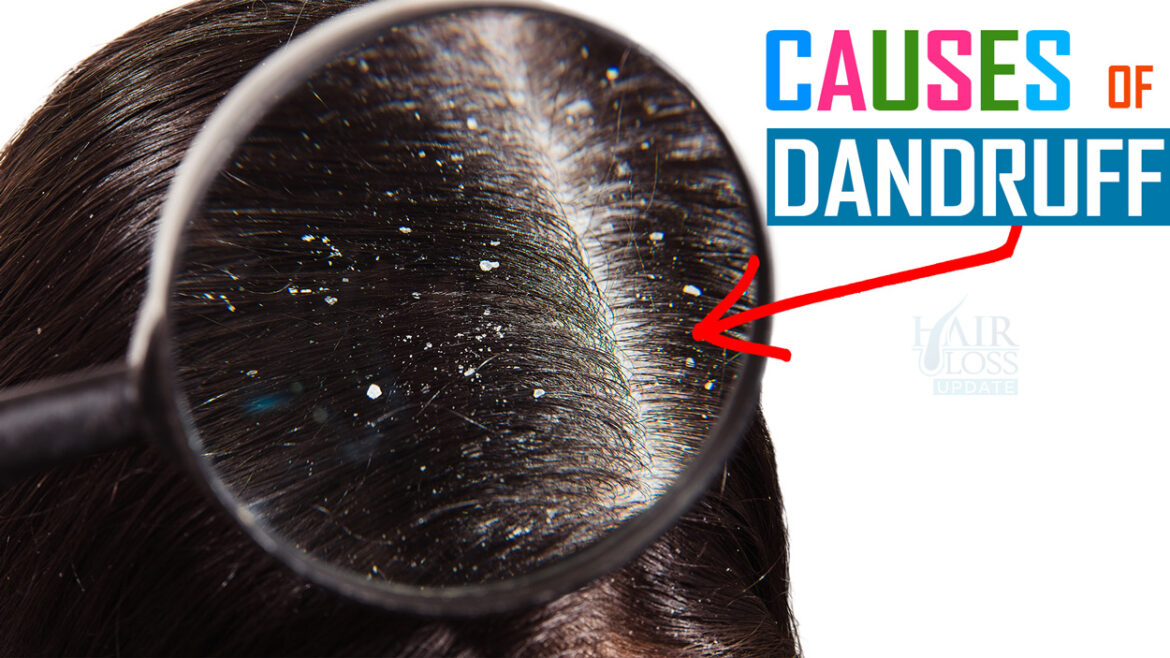Contents
Discover the root causes of dandruff and seborrheic dermatitis. Understanding dandruff causes and symptoms is important to get rid of dandruff because prevention is the best way to treat dandruff.
Ever seen those white flakes on your shoulders? I have too, and it’s really frustrating. Dandruff and seborrheic dermatitis are common scalp issues that many people face. They can be embarrassing and hard to deal with, but knowing what causes them is key to finding relief.
Dandruff is more than a simple cosmetic problem. It shows your scalp might not be as healthy as it should be. Symptoms like itching, flaking, redness, and discomfort can really affect your daily life and how you feel about yourself. But, you’re not fighting this battle alone.
Did you know dandruff is a milder type of seborrheic dermatitis? This condition can also show up on other oily parts of your body. While not contagious or serious, it can be hard to get rid of and keep under control.
In this article, we’ll look closely at dandruff and seborrheic dermatitis. We’ll cover their causes, symptoms, and what might make your scalp act up. By the end, you’ll know more about these conditions and how to fight them.
Short Summary
- Dandruff is a mild form of seborrheic dermatitis
- These conditions affect oily areas of the body, not just the scalp
- Symptoms include flaking, itching, and redness
- Stress, fatigue, and seasonal changes can make things worse
- Understanding the causes is crucial for effective treatment
- These conditions are common but can be managed with proper care
What is Dandruff and Seborrheic Dermatitis?
Dandruff and seborrheic dermatitis are common scalp issues. They affect many people. Let me explain these conditions and their link to help you understand your flaky scalp.
Defining Dandruff
Dandruff is a mild scalp issue marked by flaking skin cells. It leads to white or yellowish flakes on the scalp and shoulders. People often feel an itchy, dry scalp. This condition is more common in men and starts during puberty, peaking at age 20.
Seborrheic Dermatitis Explained
Seborrheic dermatitis is a severe form of dandruff. It causes red, scaly patches on the scalp and can hit other oily body areas. This condition is linked to an overgrowth of yeast on the skin. About 42% of infants and more adults over 50 get it.

Relationship Between Dandruff and Seborrheic Dermatitis
Dandruff and seborrheic dermatitis are closely linked. Dandruff is seen as a mild form of seborrheic dermatitis. Both cause an itchy, flaky scalp, but seborrheic dermatitis is more severe and widespread. They share triggers like oily skin, stress, and certain medical conditions.
| Characteristic | Dandruff | Seborrheic Dermatitis |
|---|---|---|
| Severity | Mild | Moderate to severe |
| Affected Areas | Mainly scalp | Scalp, face, chest, and other oily areas |
| Symptoms | Flaking, itching | Flaking, redness, scaling, inflammation |
| Prevalence | 50% of adults | 42% of infants, common in adults over 50 |
Understanding these conditions helps in choosing the right treatment. For mild cases, over-the-counter dandruff shampoos might work. But seborrheic dermatitis often needs prescription treatments. If you’re unsure about your scalp condition, it’s best to see a healthcare provider for proper diagnosis and treatment.
Common Symptoms and Signs
Dandruff can be frustrating and embarrassing. Many people deal with an itchy scalp and flaky skin. These are signs of this common condition. Let’s look at the main signs that show you might have dandruff or seborrheic dermatitis.
Flaking and Scaling
Flaky scalp is a clear sign of dandruff. You’ll see white or yellowish skin cells on your shoulders, especially with dark clothes. In bad cases, the flakes can be big and hurt your confidence.

Itching and Redness
An itchy scalp is a big sign of dandruff. The urge to scratch can be really annoying. You might also see redness on your scalp, which can look different on everyone. Some people get scalp soreness or small bumps too.
Oily or Dry Scalp
Dandruff can happen with oily or dry scalps. An oily scalp feels greasy and looks shiny. A dry scalp feels tight and flaky. Both can hurt your scalp health and cause dandruff.
Knowing these symptoms is key to keeping your scalp healthy. If you see any of these signs, you might need to use anti-dandruff products. Or, you could talk to a healthcare professional for advice.
Understanding Dandruff: Primary Causes
Dandruff affects about 50% of adults. It’s a common scalp issue. The exact cause is not known, but many factors play a part.

A key cause is Malassezia, a fungus that loves scalp oils. When dandruff hits, Malassezia grows too much. This leads to fast skin cell growth and flakes.
Oily or irritated skin can lead to dandruff. Seborrheic dermatitis makes skin oily, red, and scaly. Dry skin can also cause flakes, but they’re smaller and not as oily.
Using harsh hair products can cause dandruff-like symptoms. It’s important to pick gentle products. Skin conditions like psoriasis and eczema can also make it look like you have dandruff.
- Age (more common from teenage years to midlife)
- Stress levels
- Weather conditions
- Hormonal changes
These factors can upset the scalp’s balance, leading to dandruff. While you can’t cure dandruff, knowing what causes it helps manage it better.
The Role of Malassezia Fungus
Dandruff is more than dry skin or poor hygiene. It’s caused by a tiny fungus called Malassezia. This fungus lives on our scalps and eats the oil our skin makes.
How Malassezia Contributes to Dandruff
Malassezia breaks down sebum into oleic acid. For some, this acid irritates the scalp, making skin cells turn over fast. This leads to the white flakes we call dandruff. Studies show dandruff scalps have more Malassezia than healthy ones.

About half of us get dandruff after puberty. Men often get it more than women. This might be because men have oilier scalps, giving Malassezia more food.
Factors Influencing Malassezia Growth
Several things can make Malassezia grow too much:
- Hormonal changes
- Stress
- Climate conditions
- Pollution
- Harsh hair products
Knowing these factors helps us find the right dandruff treatment. It’s not just about washing your hair more. We need to fight the Malassezia fungus itself. Also please read my article on the common dandruff misconceptions.
| Factor | Impact on Malassezia |
|---|---|
| Sebum production | Increases food supply for fungus |
| Humid climate | Creates ideal growth conditions |
| Stress | Weakens scalp defenses |
| Infrequent washing | Allows fungus to multiply |
By focusing on scalp health and controlling Malassezia, we can stop flakes and keep skin cells balanced. It’s about working with our scalp, not against it.
Risk Factors and Triggers
Understanding what causes dandruff can help manage it. Stress, age, gender, health issues, and diet are key factors.
About half of adults worldwide deal with seborrheic dermatitis, a common cause of dandruff. It often starts in young adulthood and gets worse in the 20s. Men get dandruff more often than women.
Some health issues make dandruff more likely. This includes Parkinson’s disease, HIV, and weak immune systems. Research found 487 genes linked to dandruff. This might explain why some get it more easily.
Stress and diet can trigger dandruff. Eating too much sugar and being stressed can make it worse. Dry, cold weather also makes dandruff worse, causing more flakes and itch.
Our lifestyle affects dandruff too. Using too many hair products or not washing your hair enough can cause buildup. This can lead to dandruff. Finding the right balance is key for healthy scalp.
| Risk Factor | Impact on Dandruff |
|---|---|
| Stress | Can trigger or worsen symptoms |
| Age | Peaks in 20s, starts in young adulthood |
| Gender | More common in males |
| Medical Conditions | Increased risk with certain illnesses |
| Diet | High sugar diets may exacerbate symptoms |
Knowing these risk factors helps me take better care of my scalp. If dandruff doesn’t go away with over-the-counter treatments, seeing a dermatologist is a good idea.
Frequently Asked Questions About Dandruff
What is Dandruff?
Dandruff is a non inflammatory skin condition that mainly affects the scalp – mind you it’s the skin not the hair. Relax! You are not alone, More than 50 percent of the population is affected by dandruff and males are more affected than females. Simple Dandruff is harmless to the body, where as the more severe inflammatory form of this is called seborrheic dermatitis can be bad.
What are the signs and symptoms of dandruff?
The commonest is flaking or scaling with or without itchiness over the scalp. This can result in low social or self-esteem. This can also involve eyebrows and even beard and chest hair and can sometimes cause rashes over the skin.
What is the Actual Cause for Dandruff?
Dandruff is not about your hair, or how often you wash it. Instead, it’s about the skin on your scalp. Skin cells that grow too fast and die off too fast and shed as flakes – this is the actual mechanism which forms the dandruff flakes. This is as fast as 2 to 7 days in people with dandruff and normally this skin cell turn over should be about 30 days in normal people. Why and How exactly this happens, is still unknown.
The best understood hypothesis for dandruff is the Fungus theory. A fungus called malassezia is believed to cause the dandruff. This fungus normally lives on the scalp of most healthy adults without causing any problems. This theory says that the immune system of people with dandruff may overreact to that fungus and resulting in too fast turn over of skin cells resulting in flaking. Hence the treatment with antifungals in successful in most cases.
Why this Commonly Affects Scalp and not other areas?
According to one study, dandruff happens in association with Skin oil medically called as sebum that’s secreted by your sebaceous glands around the hair follicle And the fungus Malassezia is attracted to this oil and metabolizes the tryglycerides or fats in this oil and evokes an inflammatory response in susceptible people.
Keep Watching guys, understanding these points is very important to control dandruff. Well!
What Factors are thought to be responsible for Dandruff and flaring of Dandruff?
Many Factors are responsible Dandruff:
- Genetic Factors: If any concept remains unknown or unclear, we always blame this on our genes and that’s true most of the times.
- Stress: is another factor that can aggravate dandruff. Stress impairs your immune system and can be one of the causes of dandruff or provoking flare-ups. Also the itching may be more severe if its due to stress.
- Not Shampooing Frequently: People say frequent washing or shampooing can strip your hair of necessary oils. But here, as already discussed, oils are being utilized by the organisms to create those dandruff flakes!
- Diet: certain foods may flare-up a dandruff, like foods high in saturated and trans fats can cause your sebaceous glands to produce more oil, which makes dandruff worse.
- Over use of Hair styling Products like certain oils and styling gels can worsen dandruff.
- Season: Dandruff may fluctuate with seasons and often worsens in winter season.
Conclusion
I’ve looked into dandruff and seborrheic dermatitis, showing what they are. Dandruff is common, affecting millions, with dry skin being the most common type. Seborrheic dermatitis is a chronic condition that can spread beyond the scalp.
For dandruff, medicated shampoos with zinc pyrithione, ketoconazole, or selenium sulfide work well. For seborrheic dermatitis, stronger treatments might be needed. Natural options like tea tree oil and apple cider vinegar can also help.
Preventing dandruff is important in hair care. Eating foods rich in B vitamins, zinc, and omega-3 fatty acids helps. Washing with anti-dandruff shampoos twice a week can also help. If problems don’t go away, seeing a dermatologist is key.
Knowing about causes, symptoms, and treatments helps us manage our scalp health. With the right steps, most people can control these conditions. This way, we can have a scalp that’s free from flakes and comfortable.
